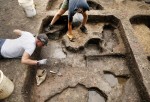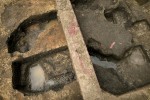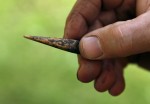 Archaeologists excavating the Burrell Orchard site in Sheffield, Ohio, have discovered the floor of a dwelling built 4,000 years ago.
Archaeologists excavating the Burrell Orchard site in Sheffield, Ohio, have discovered the floor of a dwelling built 4,000 years ago.
“There’s nothing like this anywhere in Ohio. It’s very significant, a much more significant site than we previously thought,” [excavation director Dr. Brian] Redmond said. “These are house structures. This was like a village site.”
The builders lived in what archaeologists classify as the Late Archaic period in North America, so far back that they don’t have a tribal name.
“We have no idea what they called themselves or what language they spoke,” Redmond said. “The only reason we know anything about them is archaeology.”
 The floor is about three inches thick and composed of yellow clay that was dug up elsewhere and carried to the site. Features were built into the floor, among them a basin, cooking pits, storage holes that held tools and food supplies like hickory nuts. Around the perimeter of the floor are post molds, spots of decayed organic material left in post holes that once held hickory saplings. Those saplings were tied together at the top and draped with mats of woven cattails to make a proto-wigwam.
The floor is about three inches thick and composed of yellow clay that was dug up elsewhere and carried to the site. Features were built into the floor, among them a basin, cooking pits, storage holes that held tools and food supplies like hickory nuts. Around the perimeter of the floor are post molds, spots of decayed organic material left in post holes that once held hickory saplings. Those saplings were tied together at the top and draped with mats of woven cattails to make a proto-wigwam.
This is remarkably solid construction for nomadic hunter-gatherers. They didn’t live here permanently, but rather visited the area to hunt and forage. It must have been an excellent spot for their purposes — productive, sheltered — because they stayed there for months before moving on only to return again over and over.
 The Cleveland Museum of Natural History team under Dr. Redmond first explored the Burrell Orchard site in 2008 when they discovered multiple layers of middens — ancient refuse piles — under the surface. Flint flakes, broken weapons, fire-cracked rocks, butchered animal bones and the remains of many cooking pits were found in deposits as much as 1.6 feet deep. Shovel-test excavations pinpointed the perimeter of the buried midden deposit: it is more than an acre in surface area. So vast a trash collection indicates the site was used for centuries by dozens, possibly hundreds, of hunter-gatherer families as a food collecting and processing spot.
The Cleveland Museum of Natural History team under Dr. Redmond first explored the Burrell Orchard site in 2008 when they discovered multiple layers of middens — ancient refuse piles — under the surface. Flint flakes, broken weapons, fire-cracked rocks, butchered animal bones and the remains of many cooking pits were found in deposits as much as 1.6 feet deep. Shovel-test excavations pinpointed the perimeter of the buried midden deposit: it is more than an acre in surface area. So vast a trash collection indicates the site was used for centuries by dozens, possibly hundreds, of hunter-gatherer families as a food collecting and processing spot.
The 2008 excavation also revealed the first of post molds. Some of them appeared to be the remnants of simple structures like food drying racks, but others were found in groups of three or more, which suggests the posts were used to make a more elaborate structure. They found layers of yellow-brown clay as well. While similar clay layers at archaeological sites in Illinois and Kentucky were found to be the floors of Late Archaic homes, at first the team thought the yellow clay might just be the natural subsoil underlying the middens. Digging underneath the layer revealed prehistoric artifacts, however, so either the clay was backdirt dug up from nearby pits that sank into the natural subsoil, or it was deliberately placed there to act as a floor or working surface. Now we know it’s the latter.
 In 2014, the Cleveland Museum of Natural History’s Archaeology in Action program began excavations at the Burrell Orchard site to follow up on the post molds and clay found in 2008. One of the excavation pits found the yellow clay layer with an arc of post molds following the edge of the clay that penetrate through the layer. When they returned this year, they scanned the field with Ground Penetrating Radar (GPR) and found a section that generated a very similar signal to the one caused by the 2014 floor discovery. The excavation turned up the same kinds of materials — flint flakes, fire-cracked rock, burned animal bones, burned soil, charcoal — found in the shallower layers of the 2014 find. Then the team struck gold: the yellow clay layer, this one less deep than the one from the year before. A core sample them revealed there was a second yellow clay layer at the same depth as the one found in 2014. It looks like the Late Archaic people using the site constructed a dwelling over the floor of an older one, which makes sense when you’re returning to the same spot for generations.
In 2014, the Cleveland Museum of Natural History’s Archaeology in Action program began excavations at the Burrell Orchard site to follow up on the post molds and clay found in 2008. One of the excavation pits found the yellow clay layer with an arc of post molds following the edge of the clay that penetrate through the layer. When they returned this year, they scanned the field with Ground Penetrating Radar (GPR) and found a section that generated a very similar signal to the one caused by the 2014 floor discovery. The excavation turned up the same kinds of materials — flint flakes, fire-cracked rock, burned animal bones, burned soil, charcoal — found in the shallower layers of the 2014 find. Then the team struck gold: the yellow clay layer, this one less deep than the one from the year before. A core sample them revealed there was a second yellow clay layer at the same depth as the one found in 2014. It looks like the Late Archaic people using the site constructed a dwelling over the floor of an older one, which makes sense when you’re returning to the same spot for generations.
Dr. Redmond has blogged about the 2014 and 2105 excavations on the Cleveland Museum of Natural History’s website. I suggest reading the entries chronologically to follow the discoveries as they were made.
It irritates me when people who should know better, such as archaeologists, continue to call people “nomadic” when they clearly have a permanent home that they return to. Queen Elizabeth, under this kind of use of the word, is a nomad, because she has several residences which she moves between. These people traveled most likely to known locations at specific times for harvesting various food, meeting other groups and relations, and perhaps to visit special places, and would return to home base. This is not the wandering implied by the use of the word nomad, at least as understood by most people in our culture. It could be said that many of us are more nomadic than they were. It is as if the old belief that native people did not have a sense of place is still shaping how we think about them, even when the evidence says otherwise.
Did he say “This was like a village site” or “This was, like, a village site”. I think we should be told.
You fools! You foolishly foolish fools! DON’T DIG IT UP! It was supposed to stay buried! Forgotten! For al time! Now you’ve unleashed the Hellmouth and there’s no Slayer called for our generation! WE ARE ALL DOOMED!
:skull:
I think some in the academic world are stuck in a concept that all past human activity has evolved in a linear progression to a more complex and sophisticated society, no matter where or when the settlements were located, and no matter what the evidence. Not every scientist, however. If you want a fascinating read, I suggest “Contact and Exchange in the Ancient World”, a compilation of scholarly papers that use botanical and biological evidence to argue that exchange existed between the Pacific Islands and the west coast of South America prior to Columbus, among other proposals.